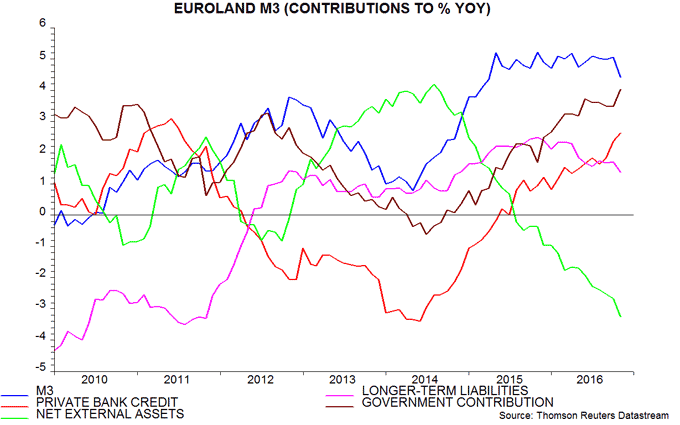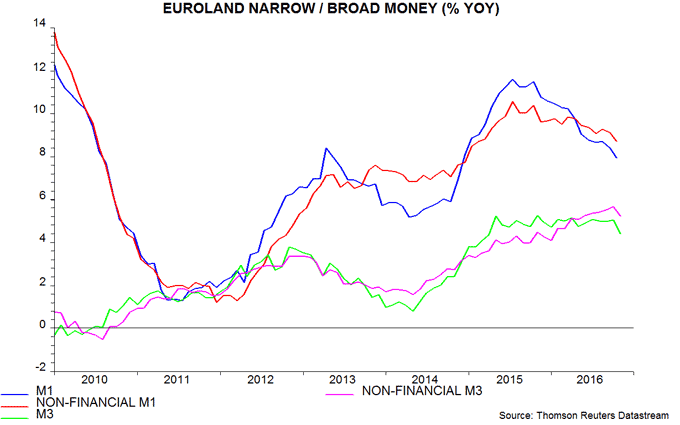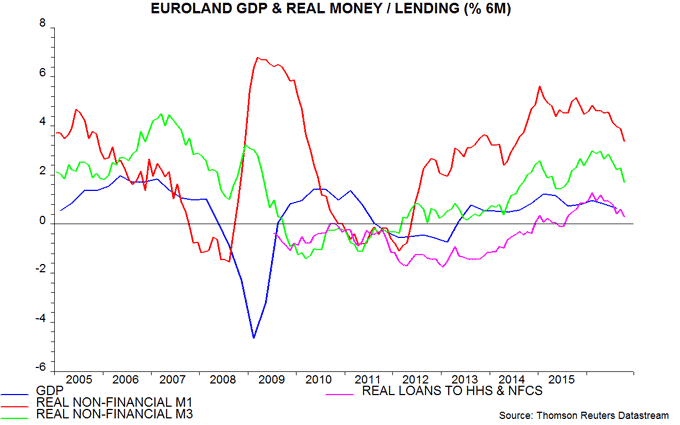Eurozone money signal neutral, QE offset by capital outflow
Eurozone broad money M3 growth has been depressed by a record outflow of capital from the region over the past 12 months. Monetary trends, nevertheless, are consistent with respectable economic growth.
Annual M3 growth fell from 5.1% in September to 4.4% in October, the lowest since March 2015. Accelerating credit to the private sector and a rising government contribution, reflecting the ECB’s QE programme, have been pushing up on M3 growth recently but have been more than offset by a fall in banks’ net external assets – see first chart.
The change in banks’ net external assets is the counterpart of the balance of payments current and non-bank capital account. The net asset position declined by €351 billion in the 12 months to October despite a €337 billion current account surplus in the 12 months to September (the latest available month). This suggests a net outflow on the non-bank capital account of about €690 billion over the past year, equivalent to 6.5% of Eurozone annual GDP.
What explains the capital haemorrhage? It is tempting to blame fiscal / structural policy paralysis, banking sector woes and political uncertainty. QE, however, is likely to have been the main driver. Evidence from other countries that have conducted QE suggests that a large portion of liquidity created has flowed abroad. The domestic monetary impact has been small or even negligible, although QE may have contributed to stronger global broad money growth.
Does the M3 slowdown signal deteriorating economic prospects? Probably not. The forecasting approach here focuses on non-financial money, i.e. held by households and non-financial corporations. The headline M3 and M1 measures have been depressed by a fall in financial sector deposits, probably reflecting weaker demand for money due to low / negative rates, with no implication for spending in the economy. Annual growth of non-financial M3 was significantly stronger than that of M3 in October, at 5.2%, down from 5.7% in September. Annual non-financial M1 growth of 8.7% similarly exceeded headline M1 expansion of 7.9% – second chart.
Six-month growth rates of real non-financial M1 / M3, admittedly, have declined notably since early 2016 – third chart. Both measures, however, are around the middle of their ranges since 2013, a period during which GDP growth has averaged about 1.5% annualised – above most estimates of potential. Economic performance in late 2016 / early 2017 may be boosted by a rise in net exports, reflecting global strength and a competitive exchange rate.

Reader Comments